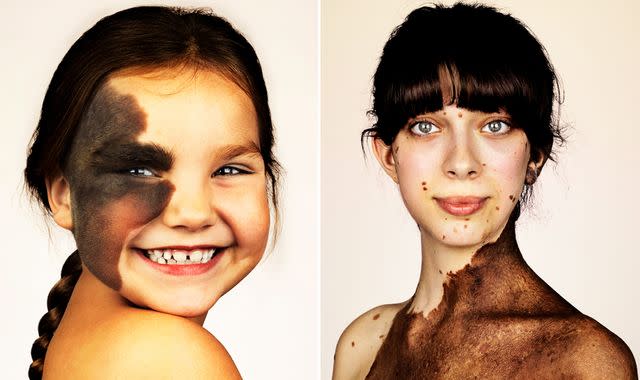Breakthrough means painful, giant moles that develop in rare condition CMN could be reversed

A new genetic therapy has been developed that could reverse giant, debilitating moles that accompany a rare skin condition.
Congenital melanocytic naevus syndrome, or CMN for short, sees children born with up to 80% of their body covered in big, painful or itchy moles.
They are caused by genetic mutations acquired in the womb - and in some cases, these moles can develop into melanoma.
During trials in mice with CMNS, researchers silenced a gene called NRAS, which triggered the mole cells to self-destruct.
The treatment could one day be used to reverse the giant moles seen in CMN patients, and potentially more common types of moles.
Veronica Kinsler, who led the research, said: "CMN is physically and mentally challenging for children and adults living with this condition and for their families.
"These results are very exciting, as not only does the genetic therapy trigger self-destruction of the mole cells in the lab, but we have managed to deliver it into the skin in mice."
She cautioned that more testing is required before the therapy can be given to patients - but it is hoped clinical trials involving people will begin soon.
The study was carried out by researchers from the Francis Crick Institute, UCL Great Ormond Street Institute for Child Health, and Great Ormond Street Hospital for Children.
It was partly funded by Caring Matters Now, a charity devoted to supporting people with CMN - and its CEO has described the results as a breakthrough that could transform lives.
Jodi Whitehouse said: "Speaking as someone who was born with CMN covering 70% of my body and having undergone more than 30 operations in my childhood to try and remove the CMN because of the fear of melanoma, with no success, this news is awe inspiring and exciting. It brings real hope to the lives of those living with CMN."
Read more from Sky News:
Rod Stewart 'booed' by German crowd
New product recalled over E.coli fears
Update on Alan Hansen's condition
Hope for families
Skin cells from children born with CMN were used in the study after being donated by their parents.
One of them is Hanna, a seven-year-old born with a dark lesion covering her back, stomach and thighs.
It leaves her skin itchy and dry, with large lumpy nodules that make sleeping at night difficult and everyday life challenging.
Ada, who is three years old, has 70% of her body covered in CMN - mostly on her neck and back.
She loves swimming and the sea, but needs to take extra precautions including additional sun protection and good clothing.
Her CMN is also itchy and painful, and she has previously undergone surgery to remove concerning nodules.
Rachelle and Greg, Ada's parents, said: "Knowing there has been a huge step forward in the CMN research and there could be a chance of Ada's CMN being reversed and possibly reducing Ada's risk of developing melanoma, has blown our expectations out the water."

 Yahoo News
Yahoo News 
